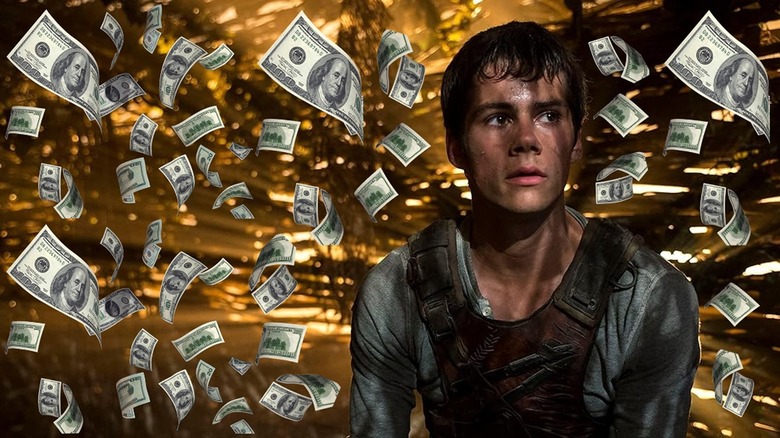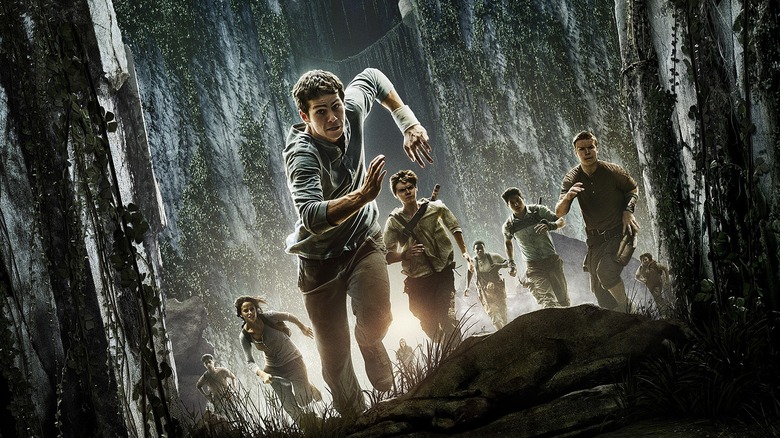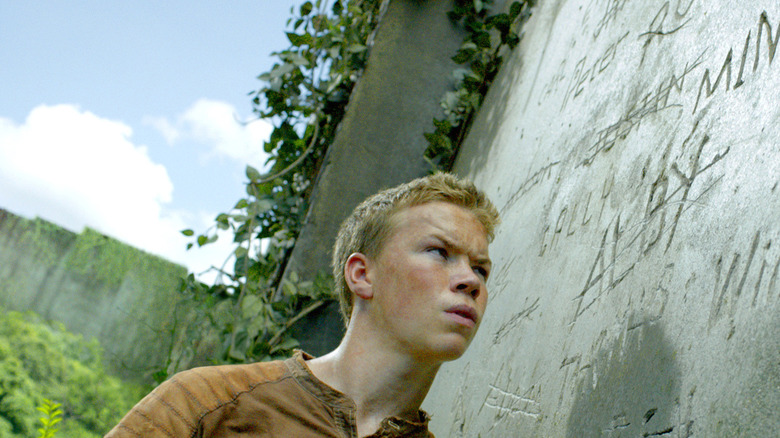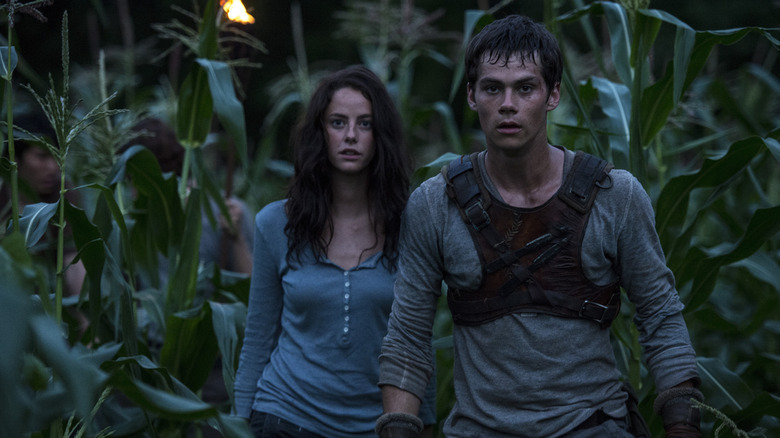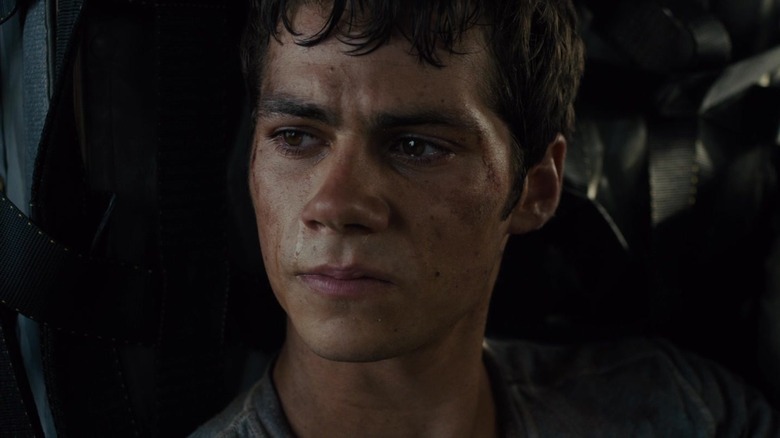10 Years Ago, The Best Bang-For-Buck Box Office Hit Of The YA Craze Arrived
(Welcome to Tales from the Box Office, our column that examines box office miracles, disasters, and everything in between, as well as what we can learn from them.)
"It's ridiculous, frankly, that a studio head, Emma Watts of Fox at the time, saw my little animated short, which was really all I had done and said, 'Here is $24 million, go make a movie.'" Those are the words of director Wes Ball speaking with DiscussingFilm in 2020. The movie in question is 2014's "The Maze Runner." While the final budget was closer to $34 million, the astonishing point remains the same. Yes, Ball getting to direct the film based on the strength of his short "Ruin" is surprising. Far more surprising? That he made a straight-up YA blockbuster for less than half what it cost to make "The Hunger Games."
Historical context is important here. In 2012, "The Hunger Games" hit it big pulling in $678 million worldwide, paving the way for a $3 billion franchise that would unfold in the ensuing years. Rather crucially, those films eventually saw their budgets balloon to well over $100 million, putting them in full-on blockbuster territory. Even the original cost around $80 million. Mind you, all of this happened after "Twilight" pulled in more than $400 million worldwide on a $37 million budget.
The YA craze was in full swing, and every studio in Hollywood was trying to cash in on it. 20th Century Fox would do so in a big, bad way, in no small part because they managed to stay thrifty for an entire trilogy.
In this week's Tales from the Box Office, we look back at "The Maze Runner" in honor of its tenth anniversary. We'll go over how the film came to be, how Ball managed to get the job despite being an untested filmmaker at the time, what he accomplished with a fraction of the money most similar movies have to work with, what happened when the movie hit theaters, and what lessons we can learn from it a full decade later. Let's dig in, shall we?
The movie: The Maze Runner
Because YA was popping off, there was something of a land grab for rights to any YA intellectual property that was there for the taking. Not all of it made it to screen, and much of what did didn't pan out. 2013's "The Mortal Instruments: City of Bones" stands as just one example of a one-and-done would-be franchise that went nowhere during this time. Fox scooped up the rights to James Dashner's "The Maze Runner" in 2011, and that proved to be a wise decision.
The film centers on a group of teens who are survivors of a major, mysterious eco-disaster. They are sent to live in a strange, isolated environment known as the Glade. After showing up with only hazy memories of the outside world, the newest and most capable "Runner" among them figures out how to escape. How does one do that, exactly? By navigating a dangerous, ever-changing maze filled with monsters called "Grievers."
As Ball explained to /Film during a set visit for "Maze Runner" in 2014, he had a meeting at Fox to pitch a three-film epic film adaptation of his sci-fi short film "Ruin." That didn't pan out. Instead, after the meeting, they gave him the Dashner's novel. Ball came up with a take on the material, bringing in pieces of concept art he created himself. Fox's president of production Emma Watts ended the meeting by saying "great, you're our director." From there, it was off to the races.
Ball rewrote the script from scratch, and even went to Dashner to get his thoughts on the adaptation. The director described the story as "Lord of The Flies meets Lost." He also described it as "a kid movie with teeth." From the brutality of what happens to the Runners in the maze to the complicated social dynamics that exist within the group that have been forced to make the Glade into a home of sorts, that seems like a fair description.
The Maze Runner had to do YA action on a tight budget
It is astounding what Ball was asked to accomplish for $34 million. To be even more clear, as he tells it, the original number was $24 million. It would be one thing if we're talking about a cast of nobody actors hanging out on an island in true "Lord of the Flies" fashion, but this is an effects-heavy, crowd-pleasing PG-13 blockbuster. From big CGI action sequences to massive sets, this would be a big ask of any director. This was Ball's feature debut.
This is such a unique thing that it's genuinely difficult to find direct comparisons for it over the last decade. Budgets either climb way higher, or anything made at this budget level is filled with less spectacle. One of the only things in the same ballpark I could find would be 2015's "Goosebumps" ($158 million box office/$58 million budget). Even that was quite a bit more expensive and quite a bit less successful. This movie exists as something of an impressive anomaly.
"To be honest, speaking frankly we don't have the budget of 'Divergent' or 'Hunger Games,'" Dylan O'Brien, who plays the film's lead Thomas, said in a 2015 interview with /Film while promoting "The Scorch Trials," the first of two "Maze Runner" sequels. "We don't have the marketing of that, it's not in everyone's face like that. I think the only reason we caught some people's attention was because it's cool. We made it really special, I think. I hope."
Fox seemed to know what they had too as they entered development on "The Scorch Trials" almost a full year before the first film even hit theaters. In fairness, the studio had reason to feel good. Aside from popular source material and other YA hits to look towards as guiding lights, the film also had a hugely promising cast. Aside from "Teen Wolf" breakout O'Brien, the ensemble also includes the likes of Kaya Scodelario ("Skins"), Will Poulter ("We're the Millers"), Thomas Brodie-Sangster ("Game of Thrones"), and the great Patricia Clarkson ("Easy A"), among others. It was a killer ensemble, one that proved to be hugely appealing for the film's target audience.
The financial journey
Fox opted to release "The Maze Runner" in theaters on September 19, 2014. This was pretty wise as September is often an ignored month by major studios. It's that post-summer, pre-awards season window that just often gets overlooked. Yet, as Warner Bros. learned with 2017's "It" and 2019's "It Chapter Two," September can be fertile ground for the right film in no small part thanks to a lack of competition. Fox learned that first with this underdog YA adaptation.
Despite the relatively limited resources at hand, the marketing was incredibly effective at selling something that appealed to younger moviegoers, while also looking distinct enough. Yes, there are "Hunger Games" elements at play, but it's far from a carbon copy. That all worked in the movie's favor. Critics were largely kind to the film, which definitely didn't hurt matters. It certainly wasn't a critical disaster like 2016's "The 5th Wave," for example.
Ball's surprisingly cheap adaptation of Dashner's novel topped the charts on opening weekend, bringing in $32.5 million. It beat out newcomers such as Liam Neeson's "A Walk Among the Tombstones" and director Shawn Levy's "This Is Where I Leave You." The film had to surrender the crown to "The Equalizer" the following weekend. Even so, it still held pretty strong with a 46% drop, pulling in another $17.4 million. But that's just domestically. The big key here is that the film was a huge success internationally.
All told, "The Maze Runner" pulled in $102.4 million domestically to go with an outsized $245.8 million overseas for a grand total of $348.3 million worldwide. Or, to put it another way, just over ten times its production budget. That's exceptionally rare air when playing in the blockbuster sandbox. Fox's decision to begin development on the sequel proved to be a very wise one.
The Maze Runner starts a full-blown franchise
"The Maze Runner" finished as the 24th biggest movie of 2014 globally, which doesn't sound that impressive on the surface. In terms of bang for buck though? It's hard to argue against, particularly within the broader context of the YA craze. That same year "The Hunger Games: Mockingjay – Part 1" made $755.3 million worldwide, but it cost $125 million to make. Lionsgate's "Divergent" also hit theaters that year, taking in $288.8 million worldwide and it cost $85 million to make. The return on investment was relatively minimal. Case in point, the "Divergent" trilogy was never finished.
On the flipside, Ball and the cast got right to work on "The Scorch Trials," which hit theaters exactly a year later on September 18, 2015. It was a similarly big hit, pulling in $312.2 million worldwide. Naturally, that meant a third installment was coming and it did indeed follow in the form of "The Death Cure" in 2018. The reason it didn't arrive sooner? O'Brien was involved in a terrible on-set accident that nearly ended his career. But he came back and that film capped off the trilogy with another hit to the tune of $288.1 million worldwide.
The budgets for the sequels increased to $61 million each. Is that a lot more? Yes. Still, by Hollywood standards, that's still incredibly cheap. All told, Fox spent $156 million (before marketing) for well over $900 million worth of ticket sales. That's a return on investment any studio would kill for.
That's probably why Disney is looking to reboot "The Maze Runner" now, with Jack Paglen penning a new film in the series. Can Disney possibly keep the budget low enough to make a reboot make sense? Frankly, in the modern era of budgets spiraling out of control, I doubt it. That makes what Ball accomplished during the course of this trilogy all the more impressive. Even after the first movie popped off, neither he nor the studio allowed things to get out of control.
The lessons contained within
The lessons here are crystal clear. As someone who harps on out of control budgets frequently, I marvel at what Ball did with so little here and applaud Fox for managing to do so much on a dime. It would have been easy for them to overdo it after the first movie hit. Instead, they showed restraint. Case in point, "The Death Cure" wasn't split into two movies like so many other franchises did with their finales. Fox didn't overextend. That's a rarity in this business.
Fox was also wise and recognized that September doesn't have to be a dump month for movies that are viewed as lesser. It's an opportunity to provide moviegoers with something worth going to the theater for, particularly if nothing else is getting in the way. With summer being so crowded these days, that's always going to be important to remember. It's amazing to me that September remains lackluster so much of the time.
I'm no filmmaker. I can't rightfully sit here and tell you why a movie should or shouldn't cost what it costs. I do know this though: Wes Ball made not one but three of these movies for shockingly low numbers. He showed it's possible. Along the way, he delivered big action and didn't compromise the experience for the viewer. Was it challenging? I can't even imagine. This is an extreme example but, to me, it makes every average-looking $200 million movie seem downright offensive. There's no excuse in my mind for such things when the "Maze Runner" movies exist. Call it reductive if you must, but if this can be done for $34 million, few movies should ever cost five or six times that much.
Ball has since gone on to bigger things, including this year's "Kingdom of the Planet of the Apes." Another great movie made for a reasonable budget — $160 million sounds like a lot, but all of that motion capture doesn't come cheap. That's the difference. My biggest of big takeaways? We should put more than a little respect on Wes Ball's name. He's earned it.
